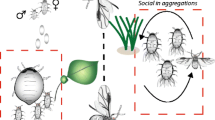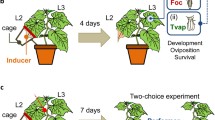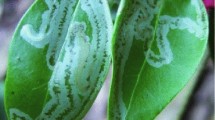Abstract
The ecological concept of opportunism is defined, and its relevance to the biology of thrips and their ability to colonise ephemeral habitats is discussed. Evolutionary patterns in host-plant exploitation are explored, revealing that thrips generally adopt the dominant elements of a flora and are rarely constrained by host-plant systematic relationships. A few pest species are highly adaptable, feeding on leaf and flower tissue as well as being predators on other arthropods. Scarcely 1% of the 5,000 described species of thrips are serious pests, and most economic literature deals with just four species. Many more thrips are potential pests, and the contribution of various aspects of their biology to opportunism, such as voltinism, vagility, aggregation and reproductive effort, are considered, together with the relevance of this information to pest control strategies.
Access this chapter
Tax calculation will be finalised at checkout
Purchases are for personal use only
Preview
Unable to display preview. Download preview PDF.
Similar content being viewed by others
References Cited
Allan, J. D. 1976. Life history patterns in Zooplankton. Amer. Naturalist 110: 165–180.
Ananthakrishnan, T. N. 1984. Bioecology of thrips. Indira Pub. Hse, Michigan.
Andrewartha, H. G. 1934. Thrips investigation 5. On the effect of soil moisture on the viability of the pupal stages of Thrips imaginis Bagnail. J. of the Council for Sci. and Ind. Res., Australia 7: 239–244.
Anon. 1993. Potted plant pests. New Scientist 137(1854): 11.
Bailey, S. F. 1957. The thrips of California. Part I: Suborder Terebrantia. Bull. Calif. Insect Sur. 4: 143–220.
Begon, M., J. L. Harper & C. R. Townsend. 1990. Ecology. Individuals, population and communities. Blackwell, Oxford.
Berlinger, M. J., S. Lebiush-Mordechi, D. Fridja & N. Mor. 1993. The effect of types of greenhouse screens on the presence of western flowers thrips: A preliminary study. Int. Org. Biol. Ctr., West Paleartic Regional Section Bull. 16(2): 13–16.
Bernardo, E. N. 1991. Thrips on vegetable crops in the Philippines, pp. 5-11. In Thrips in Southeast Asia, Proc. of a Regional Consultation Workshop, 13 March 1991. Asian Vegetable Research and Development Center, AVRDC Publication No. 91-342. Taipei.
Bhatti, J. S. 1988. The orders Terebrantia and Tubulifera of the superorder Thysanoptera (Insecta). A Critical Appraisal. Zoology (J. Pure and App. Zool.), 1: 167–240.
Bournier, A. 1961. Sur l’existence et l’évolution d’un mycétome au cours de l’embryogenèse de Caudothrips buffai Karny. Proc. 11th Int. Congress of Entomol., Wien, 1960: 352–354.
Bournier, A. 1983. Les thrips: biologie, importance agronomique. Institut National de la Recherche Agronomique. Paris. 128 pp.
Boyce, M. S. 1984. Restitution of r-and K-selection as a model of density-dependent natural selection. Ann. Rev. Ecol. and System. 15: 427–447.
Broadbent, A. B. & W. R. Allen. 1995. Effects of the interactions within the western flower thrips/tomato spotted wilt virus/host complex on virus epidemiology. In B. L. Parker, M. Skinner & T. Lewis [eds.], Thrips biology and management, Proc. The 1993 International Conference on Thysanoptera, 28-30 Sept. 1993. Plenum Publishing Corp., New York.
Brødsgaard, H. F. 1989. Frankliniella occidentalis (Thysanoptera; Thripidae) — a new pest in Danish glasshouses. A review. Danish Journal of Plant and Soil Science 93: 83–91.
Bryan, E. B. & R. F. Smith. 1956. The Frankliniella occidentalis (Pergande) complex in California (Thysanoptera: Thripidae). Univ. Calif. Pub. Entomol. 10: 359–410.
Caswell, H. 1989. Life-history strategies, pp. 285–307. In J. M. Cherrett [ed.], Ecological concepts. The contribution of ecology to an understanding of the natural world. 29th Symposium of the British Ecological Soc, London 1988. Blackwell, Oxford.
Chamberlain, J. R., J. W. Todd, R. J. Beshear, A. K. Culbreath & J. W. Demski. 1992. Overwintering hosts and wingform of thrips, Frankliniella spp., in Georgia (Thysanoptera: Thripidae): implications for management of spotted wilt disease. Envir. Entomol. 21: 121–128.
Crespi, B. J. 1990. Subsociality and female reproductive success in a mycophagous thrips: an observational and experimental analysis. J. Insect Behav. 3: 61–74.
Crespi, B. J. 1992. Eusociality in Australian gall-thrips. Nature 359: 724–726.
Darwin, C. 1859. The origin of the species by means of natural selection. Reprinted by Penguin (1985), London.
De Santo, R. S. 1978. Concepts of applied ecology. Springer-Verlag, New York.
Fennah, R. G. 1965. The influence of environmental stress on the cacao tree in predetermining the feeding sites of cacao thrips, Selenothrips rubrocinctus (Giard), on leaves and pods. Bull. Entomol. Res. 56: 333–349.
Gaston, K. J. & L. A. Mound. 1993. Taxonomy, hypothesis-testing and the biodiversity crisis. Proc. Royal Soc., London B251: 139–142.
Girling, D. J. 1992. Thrips palmi: A literature survey with an annotated bibliography. Int. Inst. Biol. Ctr., Ascot, Berkshire.
Georghiou, G. P. & C. E. Taylor. 1986. Factors influencing the evolution of resistance, pp. 143–156. In Pesticide resistance: Strategies and tactics for management. Committee on Strategies for the Management of Pesticide Resistant Pest Populations. Nat. Acad., Washington.
Greene, I. & M. Parrella. 1992. Get a grip on thrips. Greenhouse Grower 10 (13): 62–66.
Grout, T. G. & G. I. Richards. 1992. Euseius oddoensis oddoensis, an effective predator of citrus thrips, Scirtothrips aurantii, in the eastern Cape Province of South Africa. Exper. & App. Acarol. 15: 1–13.
Hansen, J. D., A. H. Hara & V. L. Tenebrink. 1992. Vapour heat: A potential treatment to disinfest tropical cut flowers and foliage. Hort. Sci. 27: 139–143.
Hata, T. Y., A. H. Hara, E. B. Jang, L. S. Imaino, B.K.S. Hu & V. L. Tenbrink. 1992. Pest management before harvest and insecticidal dip after harvest as a systems approach to quarantine security for red ginger. J. Econ. Entomol. 85: 2310–2316.
Heming, B. S. 1993. Structure, function, ontogeny, and evolution of feeding in thrips (Thysanoptera), pp. 3-41. In C. W. Schaefer & R.A.B. Leschen [eds.], Functional morphology of insect feeding, Proc.: Thomas Say Pub. in Entomol. Entomol. Soc. Amer. 162 pp.
Holm, E. 1988. Environmental restraints and life strategies: A habitat templet matrix. Oecologia 75: 141–145.
Horsfall J. L. & F. A. Fenton. 1922 (in Lewis, T. 1973). Onion thrips in Iowa. Iowa Agr. Exp. Sta. Res. Bull. 205: 65–66.
Hunter, W. B. & D. E. Ullman. 1992. Analysis of mouthpart movements during feeding of Frankliniella occidentalis (Pergande) and F. schultzei Trybom (Thysanoptera: Thripidae). Int. J. Insect Morphol. and Embryol. 18: 161–171.
Hutchinson, G. E. 1978. An introduction to population ecology. Yale Univ. Press, New Haven, CT.
Immaraju, J. A., J. G. Morse & R. F. Hobza. 1990. Field evaluation of insecticide rotation and mixtures as strategies for citrus thrips (Thysanoptera: Thripidae) resistance management in California. J. Econ. Entomol. 83: 306–314.
Immaraju, J. A., T. D. Paine, J. A. Bethke, K. L. Robb & J. P. Newman. 1992. Western flower thrips (Thysanoptera: Thripidae) resistance to insecticides in coastal California greenhouses. J. Econ. Entomol. 85: 9–14.
Kirk, W.D.J. 1984. Ecological studies on Thrips imaginis Bagnall (Thysanoptera) in flowers of Echium plantagineum L. in Australia. Australian J. Ecol. 9: 9–18.
Kirk, W.D.J. 1985. Pollen feeding and the host specificity of flower thrips (Thysanoptera). Ecol. Entomol. 10: 281–289.
Kirk, W.D.J. 1995. Feeding behavior and nutritional requirements. In B. L. Parker, M. Skinner & T. Lewis [eds.], Thrips biology and management, Proc. The 1993 International Conference on Thysanoptera. 28-30 Sept. 1993. Plenum Publishing Corp., New York.
Kisha, J.S.A. 1977. Cultural and insecticidal control of Thrips tabaci on onions in the Sudan. Ann. App. Biol. 86: 219–228.
Kring, J. B. & D. J. Schuster. 1992. Management of insects on pepper and tomato with UV-reflective mulches. Florida Entomol. 75: 119–129.
Kristensen, N. P. 1991. Phylogeny of extant Hexapods. Chapter 5, pp. 125-140. In The Insects of Australia. Melbourne Univ. Press.
Laughlin, R. 1970. The gum tree thrips, Isoneurothrips australis, the population of a single tree. Entomologia experimental is et applicata 13: 247–259.
Laughlin, R. 1977. The gum tree thrips Isoneurothrips australis Bagnall. Survival at different temperatures and humidities and its relation to capacity for dispersal. Australian J. Ecol. 2: 391–398.
Leigh, T. F. 1995. Bionomics of cotton thrips. In B. L. Parker, M. Skinner & T. Lewis [eds.], Thrips biology and management, Proc. The 1993 International Conference on Thysanoptera. 28-30 Sept. 1993. Plenum Publ. Corp., New York.
Lewis, T. 1973. Thrips: Their biology, ecology and economic importance. Academic Press, London.
MacArthur, R. H. 1972. Geographical ecology. Patterns in the Distribution of Species. Harper & Row, New York.
MacArthur, R. H. & E. O. Wilson. 1967. The theory of island biogeography. Princeton Univ. Press, Princeton, New Jersey.
Marullo, R. 1990. Attachi da Neohydatothrips gracilicornis (Williams) (Thysanoptera, Thripidae) su Pinus sp. Redia 73: 223–228.
Marzluff, J. M. & K. P. Dial. 1991. Life history correlates of taxonomic diversity. Ecol. 72: 428–439.
Matthews, R.E.F. 1991. Plant virology. 3rd ed. San Diego, Academic Press. 835 pp.
Mollema, C., G. Steenhuis & H. Inggamer. 1995. Genotypic effects of cucumber responses to infestation by western flower thrips. In B. L. Parker, M. Skinner & T. Lewis [eds.], Thrips biology and management, Proc. The 1993 International Conference on Thysanoptera. 28-30 Sept. 1993. Plenum Publ. Corp., New York.
Mound, L. A. 1971a. Gall-forming thrips and allied species (Thysanoptera: Phlaeothripinae) from Acacia trees in Australia. Bull. British Museum (Natural History). Entomol. 25: 387–466.
Mound, L. A. 1971b. The complex of Thysanoptera in rolled leaf galls on Geijera. J. Australian Entomol. Soc. 10: 83–97.
Mound, L. A. 1972a. Further studies on Australian Aeolothripidae (Thysanoptera). J. Australian Entomol. Soc. 11: 37–54.
Mound, L. A. 1972b. Species complexes and the generic classification of leaf-litter thrips of the Tribe Urothripini (Phlaeothripidae). Australian J. Zool. 20: 83–103.
Mound, L. A. 1983. Natural and disrupted patterns of geographical distribution in Thysanoptera (Insecta). J. Biogeography 10: 119–133.
Mound, L. A. 1989. Systematics of thrips (Insecta: Thysanoptera) associated with mosses. Zoological J. Linnean Soc. 96: 1–17.
Mound, L. A. 1991. The first thrips species (Insecta, Thysanoptera) from cycad male cones, and its family level significance. J. Nat. Hist. 25: 647–652.
1992. Patterns of sexuality in Thysanoptera, pp. 2-14. In E.A. Cameron et al. [eds.], The 1991 Conference on Thrips (Thysanoptera): Insect and Disease considerations in Sugar Maple Management. U.S.D.A. Forest Service, Gen. Tech. Rep. NE-161.
Mound, L. A. 1994a. Thrips and gall induction: a search for patterns. In M.A.J. Williams [ed.], Plant galls. Systematics Assoc. Special Volume No. 49, pp. 131–49. Clarendon Press, Oxford.
1994b. Los Trips de Costa Rica: su biologia, diversidad y potencial como plagas. Proc. 2nd Entomol. Cong, of Costa Rica, [in press].
Mound, L. A. & B. J. Crespi. 1994. Biosystematics of two new gall-inducing thrips with soldiers (Insecta: Thysanoptera) from Acacia trees in Australia. J. Nat. Hist, [in press].
Mound, L. A., B. S. Heming & J. M. Palmer. 1980. Phylogenetic relationships between the families of recent Thysanoptera. Zool. J. Linnean Soc. London 69: 111–141.
Mound, L. A. & J. M. Palmer. 1983. The generic and tribal classification of spore-feeding Thysanoptera (Phlaeothripidae: Idolothripinae). Bull. British Museum (Natural History). Entomol. 46: 1–174.
Mound, L. A. & A. K. Walker. 1982. Terebrantia (Insecta: Thysanoptera). Fauna of New Zealand 1: 1–113.
Morse, J. G., J. A. Immaraju & O. L. Brawner. 1988. Citrus thrips: Looking to the future. Citrograph 73: 112–115.
Nakahara, S. 1994. The genus Thrips Linnaeus (Thysanoptera: Thripidae) in the New World. USDA Tech. Bull, [in press].
Nagai, K. 1993. Integrated control of Thrips palmi Karny on egg plants in open field with Onus sauteri Poppius. Int. Org. Biol. Ctr., West Paleartic Regional Section Bull. 16 (2): 117–120.
Palmer, J. M. 1986. Thrips on English oak trees. Entomologist’s Gazette 37: 245–252.
Palmer J. M. & L. A. Mound. 1991. Thysanoptera. Chapter 22. 5: 67-76. In D. Rosen [ed.], The armoured scale insects, Their biology, natural enemies and control, Vol B. Amsterdam.
Palmer J. M., L. A. Mound & G. J. Duheaume. 1989. Guides to insects of importance to man. In C. R. Betts [ed.], 2. Thysanoptera. CAB Int. Inst. Entomol. and British Museum (Natural History), London. 73 pp.
Parry, G. D. 1981. The meanings of r-and K-selection. Oecologia 48: 260–264.
Price, P. W. 1981. Relevance of ecological concepts to practical biological control, pp. 3–19. In Beltsville Symposia in Agricultural Research, Biological control in crop production, 18-21 May 1980. Allanhead, London.
Ramakers, P.M.J. 1995. Biological control using oligophagous predators. In B. L. Parker, M. Skinner & T. Lewis [eds.], Thrips biology and management, Proc. The 1993 International Conference on Thysanoptera. 28-30 Sept. 1993. Plenum Pub. Corp., New York.
Ramakers, P.M.J., M. Dissevelt & K. Peters. 1989. Large scale introduction of phytoseiid predators to control thrips on cucumber. Med. Fac. Landbouww. Rijksuniv. Gent 54 (3a): 923–929.
Rhoades, D. F. 1985. Offensive-defensive interactions between herbivores and plants: their relevance in herbivore population dynamics and ecological theory. The Amer. Naturalist 125: 205–238.
Ricklefs, R. E. 1979. Ecology, 2nd ed. Chiron Press, New York.
Roff, D. A. 1992. The evolution of life histories; theory and analysis. Chapman & Hall, NY.
Sakimura, K. 1986. Thrips in and around the coconut plantations in Jamaica, with a few taxonomical notes (Thysanoptera). Florida Entomol. 69: 348–363.
Shipley, B., P. A. Keddy, D.R.J. Moore & K. Lemky. 1989. Regeneration and establishment strategies of emergent macrophytes. J. Ecol. 77: 1093–1110.
Smith, R. L. 1980. Ecology and Field Biology, 3rd ed. Harper & Row, New York.
South, L. 1991. New thrips threatens south Florida. Amer. Veg. Grower 39 (5): 30.
Southwood, T.R.E. 1977a. Habitat, the templet for ecological strategies? J. Animal Ecol. 46: 337–365.
Southwood, T.R.E. 1977b. The relevance of population dynamic theory to pest status, 35-54. In J. M. Cherrett & G. R. Sagar [eds.], Origins of pest, parasite, disease and weed problems. 18th Symp. British Ecolog. Soc., Bangor 1976. Blackwell, Oxford.
Southwood, T.R.E. 1988. Tactics, strategies and templets. Oikos 52: 3–18.
Southwood, T.R.E., R. M. May, M. P. Hassell & G. R. Conway. 1974. Ecological strategies and population parameters. The Amer. Naturalist 108: 791–804.
Steams, C. S. 1976. Life-history tactics: A review of the ideas. The Quarterly Rev. Biol. 51: 3–47.
Stenseth, N. C. 1981. How to control pest species: Application of models from the theory of island biogeography in formulating pest control strategies. J. App. Ecol. 18: 773–794.
Stenseth, N. C. 1987. Evolutionary processes and insect outbreaks, pp.533–563. In P. Barbosa & J. C. Schultz [eds.], Insect outbreaks. Academic Press, San Diego.
Strauss, S. Y. & R. Karban. 1995. Local adaptation by thrips to individual plant clones: Effects of dispersal and reproduction. In B. L. Parker, M. Skinner & T. Lewis [eds.], Thrips biology and management, Proc. The 1993 International Conference on Thysanoptera. 28-30 Sept. 1993. Plenum Publ. Corp., New York.
Taylor, D. R., L. W. Aarssen & C. Loehle. 1990. On the relationship between r/K selection and environmental carrying capacity: a new habitat templet for plant life history strategies. Oikos 58: 239–250.
Teerling, C. 1995. The biology and chemical ecology of western flower thrips. In B. L. Parker, M. Skinner & T. Lewis [eds.], Thrips biology and management, Proc. The 1993 International Conference on Thysanoptera. 28-30 Sept. 1993. Plenum Publ. Corp., New York.
Terry, I. 1995. Competition in western flower thrips males: effects of density on behaviour. In B. L. Parker, M. Skinner & T. Lewis [eds.], Thrips biology and management, Proc. The 1993 International Conference on Thysanoptera. 28-30 Sept. 1993. Plenum Publ. Corp., New York.
Teulon, D.A.J., B. Hollister & E. A. Cameron. 1993a. Behavioral responses of western flower thrips to anisaldehyde, and applications for trapping in greenhouses. Int. Org. Biol. Ctr., West Paleartic Regional Section Bull. 16 (2): 177–180.
Teulon, D.A.J., J. W. Groninger & E. A. Cameron. 1994a. Distribution and host plant associations of Taeniothrips inconsequens (Uzel) (Thysanoptera: Thripidae). Envir. Entomol. 23: 587–611.
Teulon, D.A.J., T. E. Kolb, E. A. Cameron, L. H. McCormick & G. A. Hoover. 1994b. Pear thrips, Taeniothrips inconsequens (Uzel) (Thysanoptera: Thripidae), on sugar maple, Acer saccharum Marsh.: A review. Zoology (J. Pure and App. Zool.) 4: 355–380.
Teulon, D. A.J. & D. R. Penman. 1990. Host records for the New Zealand flower thrips (Thrips obscuratus (Crawford) Thysanoptera: Thripidae). New Zealand Entomol. 13: 46–51.
1994. Phenology of the New Zealand flower thrips, Thrips obscuratus (Crawford) (Thysanoptera: Thripidae), on nectarine and peach flowers. New Zealand Entomol. 17 (in press).
1995. Thrips obscuratus (Crawford) (Thysanoptera: Thripidae): A pest of stonefruit in New Zealand. In B. L. Parker, M. Skinner & T. Lewis [eds.], Thrips biology and management, Proc. The 1993 International Conf. on Thysanoptera. 28-30 Sept. 1993. Plenum Publ. Corp., New York.
Teulon, D.A.J., D. R. Penman & P.M.J. Ramakers. 1993b. Volatile chemicals for thrips (Thysanoptera: Thripidae) host finding and possible applications for thrips pest management. J. Econ. Entomol. 86; 1405–1415.
Townsend, K. 1993. New Zealand Herald, 20 April, 1993.
Ullman, D. E., D. M. Westcot, W. B. Hunter & R.F.L. Mau. 1989. Internal morphology of Frankliniella occidentalis with special reference to interactions between thrips and tomato spotted wilt virus. Int. J. Insect Morphol. and Embryol. 18: 289–310.
Velusamy, R. & R. C. Saxena. 1991. Genetic variation for resistance to rice thrips (Thysanoptera: Thripidae) in leafhopper-and plant hopper-resistant rice varities. J. Econ. Entomol. 84: 664–668.
Winemillar, K. O. 1992. Life-history strategies and the effectiveness of sexual selection. Oikos 63: 318–327.
zur Strassen, R. 1995. On binomial data of some predacious thrips. In B. L. Parker, M. Skinner & T. Lewis [eds.], Thrips biology and management, Proc. The 1993 International Conference on Thysanoptera. 28-30 Sept. 1993. Plenum Publ. Corp., New York.
Author information
Authors and Affiliations
Editor information
Editors and Affiliations
Rights and permissions
Copyright information
© 1995 Springer Science+Business Media New York
About this chapter
Cite this chapter
Mound, L.A., Teulon, D.A.J. (1995). Thysanoptera as Phytophagous Opportunists. In: Parker, B.L., Skinner, M., Lewis, T. (eds) Thrips Biology and Management. NATO ASI Series, vol 276. Springer, Boston, MA. https://doi.org/10.1007/978-1-4899-1409-5_1
Download citation
DOI: https://doi.org/10.1007/978-1-4899-1409-5_1
Publisher Name: Springer, Boston, MA
Print ISBN: 978-1-4899-1411-8
Online ISBN: 978-1-4899-1409-5
eBook Packages: Springer Book Archive




